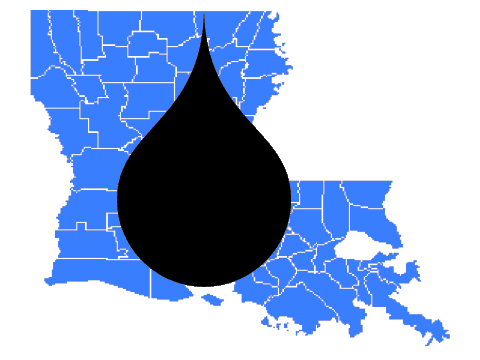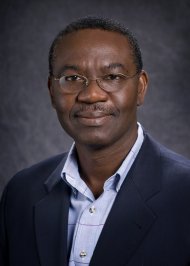LSU Center for Energy Studies to co-host energy efficiency workshop with Entergy, Pew Center, America’s WETLAND Foundation
Entergy Corporation and the Pew Center on Global Climate Change, with the LSU Center for Energy Studies and America’s WETLAND Foundation, will present “Make an Impact,” a workshop on climate change, emissions reduction policy, impacts for Louisiana, and the role of individual action, Thursday, November 19, 10:30 a.m. to 12:30 p.m. The workshop will be held in the Dalton J. Woods Auditorium and lobby of the Energy, Coast & Environment Building on the LSU campus. The event is free and open to the public. A drawing for a bicycle from The Bicycle Shop will be held to encourage bicycle commuting.
Following a 10 a.m. press conference and welcoming remarks from Mayor Kip Holden, the program will begin at 10:30 a.m. with a panel discussion and question-and-answer session featuring community leaders and energy and environmental experts. Panelists will include Mike McDaniel, professional-in-residence at the Center for Energy Studies; Sidney Coffee, senior adviser to the America’s WETLAND Foundation; and representatives from Entergy and the Pew Center.
The program will also feature exhibits by community vendors sharing information on local programs and services, ranging from recycling and rain barrels to home energy audits.
The “Make an Impact” program also includes a website (http://entergy.pewclimate.org/), launched in July by Entergy and the Pew Center, designed to provide tools for consumers to manage their environmental impact, reduce energy costs, and help lower CO2 emissions. The site offers personalized tips to help consumers lower energy bills and includes a customized carbon calculator to analyze personal energy use and an interactive page of local resources.
Reserved parking will be available for attendees. Contact Marybeth Pinsonneault at 225-578-3948 or mtherio@lsu.edu for more information.
DOE Funds Industry-LGS Partnership for Geothermal Research
The first award will fund a project to capture, condition, and transport CO2 from facilities located along the Mississippi River between Baton Rouge and New Orleans for geologic storage. The LGS will perform a technical review of geologic information, assist in obtaining geologic data, and provide technology transfer and local outreach. LGS funding is $75,000 for the first seven months. The project is headed by Shell Exploration and Production Company.
The second award, to a consortium led by Louisiana Geothermal, funds a three-year project to demonstrate the feasibility of a geopressured-geothermal power plant in Cameron Parish, Louisiana. The LGS award is $297,820.
The third award funds the Natural Geothermal Data System (NGDS), an integrated distributed and searchable data system of state-specific geothermal data, which is expected to drive renewed efforts to identify, assess, and exploit geothermal energy resources in the U.S. A consortium headed by the Arizona Geological Survey and including 40 state geologic surveys will participate in populating the data system with relevant geothermal data. LGS funding from this award is $299,979 over three years.
The principal investigator for the three projects is Chacko J. John, LGS director and state geologist and professor-research. LGS research associate Brian Harder is co-principal investigator.
Center for Energy Studies Examines the Economic Importance of the Port of Venice
Timely investment in the Port of Venice could elevate it into a significant world-class offshore oil and gas service port along the Louisiana Gulf Coast, according to a report released by the LSU Center for Energy Studies (CES). The Port of Venice Complex, commonly referred to as the “Gateway to the Gulf,” would benefit considerably from the service and maintenance activities arising from new drilling and production operations in the eastern Gulf of Mexico.
“The Port of Venice is exceptionally well-positioned to take advantage of new eastern Gulf of Mexico drilling and production prospects, creating economic development opportunities for the local and state economies, and reducing U.S. dependence on foreign sources of energy,” said Professor David Dismukes, Center for Energy Studies associate executive director and principle investigator for the study. “However, these opportunities won’t happen without continued investment in the waterways and channels leading into the port complex.”
Venice’s contribution to the Louisiana economy is not well known. While other, more visible ports in the state focus almost exclusively on federal deepwater production, Venice provides support to a balanced mix of state and federal drilling and production activities in the Gulf. Most importantly, Venice supports in-state production activities that are estimated to contribute more than $350 million per year in mineral revenues directly to Louisiana and not to the federal government. The area serviced by Venice accounts for some 20 percent of all in-state mineral revenues.
Over the past five years, Venice has supported in-state oil and gas production activities that have contributed some $1.69 billion in state mineral revenues. "An investment in Venice is clearly a direct investment in Louisiana and one that yields almost immediate economic and financial benefits that are not dependent upon the irregularities of federal royalty revenue policies," Dismukes said.
The CES economic impact analysis of the Port was based upon a detailed tenant and port user survey that incorporated economic impact models and analyses, as well as sophisticated satellite tracking measurements to examine vessel movements into, out of, and through the port to state and federal drilling and production locations.
The CES impact study estimated that the Port will have made more than $117 million and $188 million in capital investments in 2008 and 2009, respectively. These capital investments, comprised of infrastructure improvements and marine vessel expenditures, will lead to more than 1,070 jobs for the local economy and neighboring Louisiana parishes.
Annual operations at the Port are estimated to create more than $197 million in economic activity in both 2008 and 2009. Over the past two years, the Port has employed, on average, more than 850 people in the local economy.
The Port has a significant competitive advantage in serving the new offshore areas recently slated for drilling in the eastern Gulf. The geographic location of the Port of Venice gives it the ability to provide oil and gas service companies a 6-to-95 percent fuel cost advantage to important eastern Gulf of Mexico lease sales relative to other central and eastern GOM ports in Louisiana, Mississippi, Alabama and Florida.
Click here to view or download a copy of the report.
The LSU Center for Energy Studies is pleased to announce the Fall 2009 recipients of the Robert R. Brooksher /LMOGA Scholarship and the first F. Malcolm Hood Scholarship.
Three students have been awarded the $500 Brooksher scholarship:
Senior geology major Jesse Landreneau from New Orleans (a two-time recipient)
Petroleum engineering majors Alaina Johnson and Allison Kuykendall.
The scholarship is named for the late Robert R. Brooksher, Jr., who was executive vice president of Louisiana Mid-Continent Oil and Gas Association and a founding member of the LSU Center for Energy Studies’ Advisory Council.
The first F. Malcolm Hood Scholarship, a $400 award named for the long-time supporter of the LSU Center for Energy Studies, has been awarded to Peyton Tippett, a junior petroleum engineering major from Bossier City, La.
The Hood scholarship was created to honor the late F. Malcolm Hood, a highly regarded energy industry spokesman who served as an advisor when the Center was created and was a member of its Advisory Council.
Discovery Channel News Cites Louisiana Geological Survey Research
The work of Louisiana Geological Survey research associate Paul Heinrich was recently cited in two Discovery Channel website news articles about the discovery of a giant clawed dinosaur unearthed in a Utah desert. The dinosaur, Nothronychus graffami, stood 13 feet tall and had nine-inch-long hand claws. One mystery surrounding the skeleton is how the well-preserved remains of the terrestrial dinosaur came to rest in marine sediments about 60 miles from the nearest contemporaneous prehistoric shoreline. In a Discovery.com interview July 17, Lindsay Zanno, John Caldwell Postdoctoral Fellow in the Department of Geology at the Field Museum and lead author of the Proceedings of the Royal Society B paper that describes the new dinosaur, mentions that one possible solution to this mystery was suggested by Heinrich at the 2008 Geological Society of America (GSA) Meeting Houston. In his GSA paper, Heinrich proposes that this dinosaur drifted out to sea on a solid mass of vegetation called a “floating island,” a formation solid and buoyant enough to have transported animals as large and heavy as this dinosaur. Floating islands offer a similar solution to other anomalous finds of well-preserved dinosaur remains in marine sedimentary rocks far from contemporary shorelines.
In an earlier Discovery.com article about the dinosaur, Discovery News writer Jennifer Viegas cited Heinrich’s work as well: http://dsc.discovery.com/news/2009/07/14/sickle-claw-dinosaur.html
To read the interview with Zanno, in which she mentions Heinrich’s work, visit http://blogs.discovery.com/news_animal/2009/07/giant-clawed-dinosaur-from-utah-discovery-interview-with-expert-lindsay-zanno.html
Related links
Heinrich, P. V., 2008, Floating Islands as Taphonomic Agents In the Offshore Dispersal
of Vertebrate Remains. Geological Society of America Abstracts with Programs, Vol.
40, No. 6, p. 371.
http://gsa.confex.com/gsa/2008AM/finalprogram/abstract_146094.htm
HERIZINOSAUR, Mystery of the Sickle-Claw Dinosaur
http://www.musnaz.org/exhibits/therizinosaur.html
http://www.azgs.state.az.us/Summer_07.pdf
America's Energy Coast Issues Conflicting Federal Policies Resolution
America’s Energy Coast
Commerce and Infrastructure Task Force Resolution
Presented: July 30, 2009
Biloxi, Mississippi
Conflicting Federal Policies Resolution
Can Louisiana Make a Buck after Climate Change Legislation?
A Look at How Changes in Washington Will Affect Louisiana's Energy Producers and Consumers
presented by:
Louisiana Association of Business & Industry
U.S. Chamber of Commerce
LSU Center for Energy Studies
Louisiana Oil and Gas Association
21 August 2009
Energy, Coast & Environment Building
Louisiana State University
Click here to view the PDF flyer for more information and registration
Click here to view the revised agenda
The Carbon Emissions Continuum: From Production to Consumption

Join us for a breakfast briefing on the carbon capture continuum—from study and production
to capture and consumption.
Jones Walker has assembled a team of notable experts to discuss the challenges and opportunities with CO2 emissions.
Thursday, July 23, 2009
8:30–11:00 a.m.; Breakfast will be served
.
Energy, Coast & Environment Building
Louisiana State University
Baton Rouge, LA 70803
.
Also available by webinar
Don G. Briggs: President, Louisiana Oil & Gas Association
James H. “Jim” Welsh, Commissioner of Conservation, State of Louisiana
Dr. David E. Dismukes, Associate Executive Director, Center for Energy Studies
Dr. Michael McDaniel, Professional-in-Residence, Center for Energy Studies and Former Secretary, Louisiana Department of Environmental Quality
Moderated by members of Jones Walker’s Green Law & Sustainability Team
Marjorie A. McKeithen, Robert W. Scheffy, Jr., and Michael A. Chernekoff
Registration required by July 15 to arrange complimentary parking accommodations:
Courtney Lona 504.582.8121 or clona@joneswalker.com
Additional information and registration.
Introduction
Petroleum industry analysts once thought that the Gulf of Mexico (GOM) region could
no longer attract the big exploration and production (E&P) investors. However, the
GOM has re-emerged as the key focal point of oil and gas activity in the world, especially
with respect to deepwater operations The reason for this turnaround has been attributed
to several technical advancements in deep offshore drilling and production technology.
Because of innovations in technology, areas in the Gulf of Mexico once thought beyond
reach in terms of water depth are now explored and developed successfully. Several
other factors underlying the turnaround in the attractiveness of the GOM region to
E&P investors include the changing structure of the OCS oil and gas industry, government
regulatory programs and fiscal incentives, technical progress, and the global market
fundamentals resulting in high oil and natural gas prices.
Brooksher Scholarship Recipients Announced
The LSU Center for Energy Studies is pleased to announce the recipients of the Robert R. Brooksher /LMOGA Scholarship for Spring 2009. Junior geology major Jesse Landreneau of Carthage, Texas, and senior geology major Jessica Mumphrey of Baton Rouge were chosen to receive the $500 award.
The scholarship is named for the late Robert R. Brooksher, Jr., who was executive vice president of Louisiana Mid-Continent Oil and Gas Association and a founding member of the LSU Center for Energy Studies’ Advisory Council.
The award, intended to be applied toward the purchase of books, is given to a junior or senior in an energy-related discipline based on academic credentials.
The Society of Petroleum Engineers (SPE) has honored Wumi Iledare with SPE Regional Technical Award for Management and Information (Africa). The SPE award acknowledges the contributions of Iledare to the Society of Petroleum Engineers at the regional level and recognizes the devotion of his time and effort to the development of technical expertise in the management and information discipline, especially in Africa.
Over the past ten years, Iledare has volunteered his time to advance technical proficiency of graduate students in petroleum economics by serving as a visiting professor of petroleum economics to tertiary institutions in Africa, including the Institute of Petroleum Studies, African University of Science and Technology, and the University of Ibadan. He has presented and published several research papers on petroleum economics in conference proceedings of the SPE Nigeria Annual International Conferences and Exhibitions in Abuja, Nigeria, and also the SPE Annual Technical Conferences in the U.S. He has served as a facilitator for workshops on oil and gas economics and policy in Nigeria, and taught short courses at SPE conferences organized by the SPE Nigeria Council to advance technical competency of professional engineers in the management and information discipline of SPE.
The Compelling Case for Natural Gas Vehicles (NGV)
9:00 a.m. – 4:30 p.m.
Thursday, January 22, 2009
Shreveport Convention Center
Click here for more information
Greenhouse Gases Inventory Kicks-Off with Project Advisory Team Meeting
CES Professional-in-Residence Mike McDaniel presented an overview of the Louisiana Economic Development (LED)-supported greenhouse gases (GHG) inventory project to members of the Project Advisory Team (PAT).
The PAT includes representatives from stakeholder groups, including electric utilities, conservation/NGOs, oil and gas industry, chemical manufacturing, business and commerce, agriculture and forestry, and affected state agencies such as the Louisiana Department of Natural Resources, the Louisiana Department of Environmental Quality, and LED. PAT members will offer technical and outreach assistance for the GHG inventory project as it progresses toward the completion date, which is set for June 2009.
This GHG inventory will be the second completed by CES and is intended to be a comprehensive state-wide inventory of sources and sinks of greenhouse gases. The project has been designed to help assess potential impacts of expected federal GHG emissions regulations on the state of Louisiana and to help strategically position the state to accommodate challenges and opportunities brought by the federal regulations . The overarching purpose of the LED GHG Inventory Project is to assure that Louisiana's economic competitiveness is not compromised by possible federal regulation of greenhouse gases and that any associated economic development opportunities are recognized.
The planned Scope of Work for the project reaches beyond the development of a comprehensive state-wide GHG inventory to include
review and evaluation of activities undertaken by other states to accommodate possible
greenhouse gas regulation and/or climate change concerns;
high-level assessment of the impacts of the most likely federal GHG regulatory schemes
on Louisiana's economy;
development of recommendations for potential state and industry strategies.
Methods used will be derived primarily from U.S. Environmental Protection Agency (EPA)
guidance documents.
The principle investigators for the project are Mike McDaniel and David Dismukes. Additional CES staff involved in the project includes Elizabeth Dieterich, Kathryn Perry, and Lauren Stuart. A copy of the PAT presentation, including a list of Project Advisory Team members, as well as references and important documents related to the LED GHG Inventory Project will also be posted online soon.
Louisiana Oil and Gas Symposium
May 19-20, 2009
Dalton Woods Auditorium
Energy, Coast & Environment Building
Louisiana State University
Baton Rouge, Louisiana
Featured topics: Louisiana shale plays and oil and gas regulation
Potential speakers:
Abstracts due April 1, 2009
Expanded abstracts due April 18, 2009
For more information visit BRGS website at http://www.brgs-la.org
If you have any questions please contact John E. Johnston III at hammer@lsu.edu or phone 225-578-8657.

